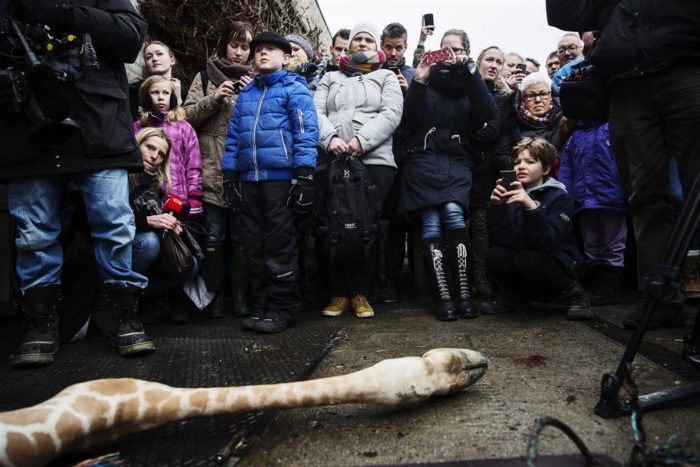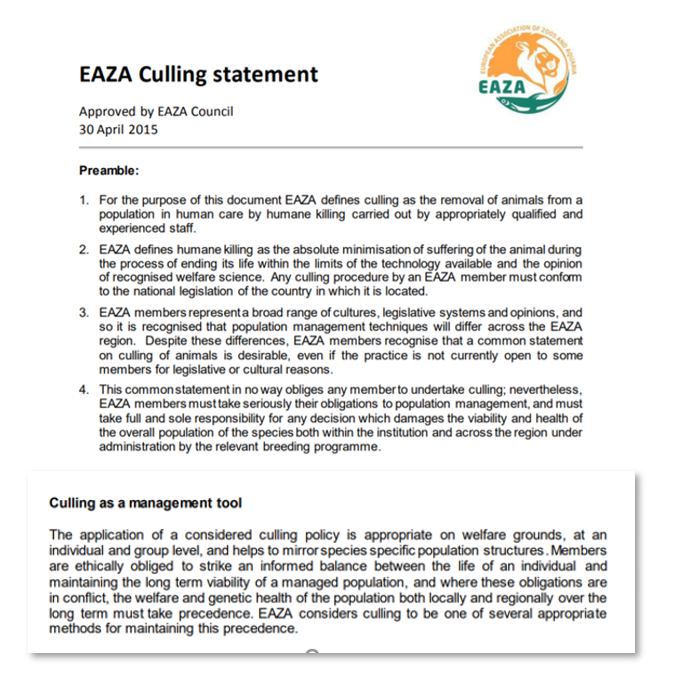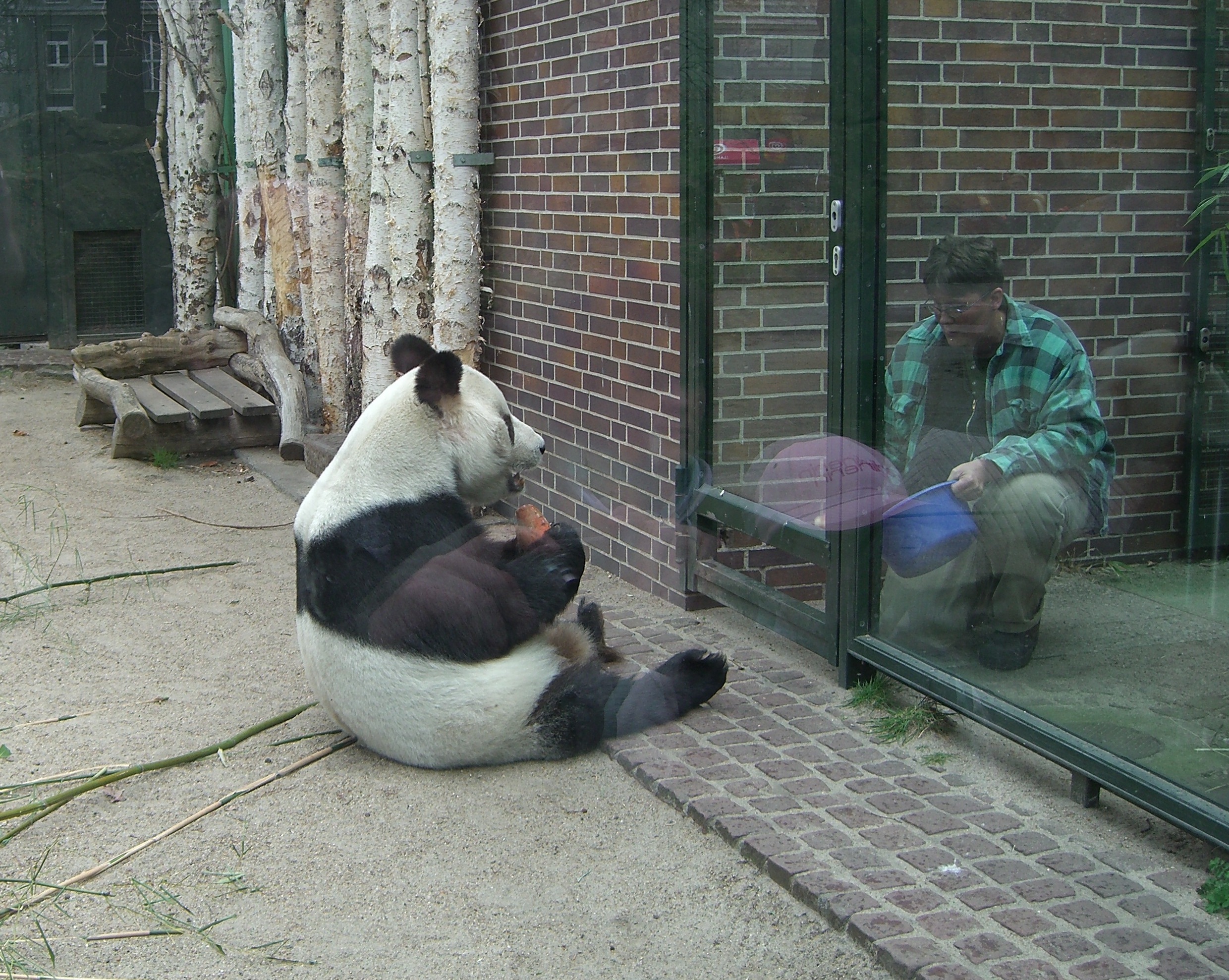Can you remember the first time you visited a zoo? The thrill of watching the dusty elephants washed down in their concrete enclosure, clustering around ‘baboon rock’ where monkeys flashed their purple bottoms at mum and dad, the dead giraffe you saw dismembered in front of you and fed to the lions… What? Not that last one? Well, that was part of the educational zoological experience for visitors to Copenhagen Zoo on 9 February 2014. The slaughter of Marius, a healthy 18-month-old giraffe, considered useless for breeding because of his too-common genes, was followed by his dissection in front of a crowd that included children.

Marius. Image by Kasper Palsnov/Scanpix Denmark/Reuters.
In zoos, fertile animals are considered healthy: a successful breeding program suggests good welfare and allows a zoo to build the captive gene pool of a species, used to further replicate animals. The zoo profits from selling animals or semen to other zoos, or live breeding with another zoo’s inhabitants; what Julie Woodyer of Zoocheck Canada calls “musical semen” [1]. Unfortunately there’s not enough space for all this breeding, so animals from well-bred genetic lines end up being declared ‘surplus’. These spare sentient beings are then ‘culled’ to prevent in-breeding within the captive breeding program [2]. Marc Bekoff calls this lethal management of healthy animals ‘zoothanasia’ [3]. Copenhagen Zoo’s Scientific Director Bengt Holst told the BBC shortly after Marius’ death, ‘We do it when it’s necessary. If I should take an average over 10 years – it could be probably something like 20, 30 [per year]’ [4]. Perhaps we should give Holst credit for being open about his zoothanasia policy – after all, every other zoo in Europe does the same thing. In January 2018, for instance, nine ‘useless’ lions cubs were killed at Sweden’s Boras Djurpark. The European Association of Zoos and Aquaria (EAZA), who require their 340 zoos to record every animal’s birth and death in ‘studbooks’ [5], estimate that somewhere between 3,000 and 5,000 animals are ‘management-euthanised’ in Europe each year [6].

EAZA Culling statement [7]
The alternative is to make sure that ‘surplus’ animals are not born in the first place, using contraceptives or hormones. More commonly practised in America, this strategy seems most humane but actually deprives animals of their most basic natural behaviours: giving birth and raising young. European zoos more often allow animals to mate and bear offspring as compensation for depriving them of their other instinctual pleasures. Holst points out ‘If we take away their parenting behaviour, they would not have much left’ [8]. Once the young reach the age at which they would become independent in the wild, they are removed and usually killed. Animal photographer Jo-Anne McArthur considers:
Killing someone shows you don’t give a stuff about them as an individual. And yet, it’s “funny”, zoos do a lot of marketing of their new babies, giving them a name, “Come see so-and-so!” etc. [Zoos] claim they care so much about the animals in their custody. With Marius and the thousands of other “surplus” animals, killing them tells another story [9].
Ethicist Koen Margodt believes zoos present themselves as arks in which animals are collected to be ‘saved’ from extinction but, in actuality, human interests are put before those of individual animals [10]. Take the panda: fewer than 2,000 remain in the wild, occupying less than one percent of their historic range, yet the captive population has more than doubled since 2005. Lucy Cooke shows how we ‘reduce’ pandas to justify their removal from the wild into ‘protective cages’, the image of ‘the pathetic panda—a benign, bungling creature who needs human help to survive— a very modern myth’ [11]. The problems with breeding pandas in captivity are especially misleading: a dominant male in the wild can have sex over 40 times in an afternoon and a Giant Panda’s semen contains 10 to 100 times more sperm than a human male.

Panda in Berlin Zoo. Image by Times, 2007 (GNU Free Documentation License)
Rather than sponsoring an animal in captivity or giving zoos entrance money, a more effective strategy might be to make changes to our own lifestyles that help protect wild animals in their natural habitats. Reducing consumption of animal products prevents further deforestation (destruction of animal homes) for growing feed crops and lowers harmful global-warming carbon emissions from livestock [12] [13]. Perhaps the answer is not to zoothanise or sterilise, but to stop keeping animals in captivity at all, and instead focus conservation efforts on protecting their natural homes.
References
[1] Bekoff, M. (2014). Is going to a zoo like shopping for a car? Musical Semen. Psychology Today. 11 Nov. Available at: https://www.psychologytoday.com/us/blog/animal-emotions/201411/is-going-zoo-shopping-car-musical-semen [Accessed 15 January 2019].
[2] European Association of Zoos and Aquaria (2015). EAZA Culling statement. Available at: https://www.eaza.net/assets/Uploads/Position-statements/EAZA-Culling-statement.pdf [Accessed 15 January 2019].
[3] Bekoff, M. and Pierce, J. (2017). The Animals’ Agenda: Freedom, Compassion, and Coexistence in the Human Age, Beacon Press.
[4] Barnes, H. (2014). How many healthy animals do zoos put down? BBC News Magazine. 27 Feb. Available at: https://www.bbc.co.uk/news/magazine-26356099 [Accessed 15 January 2019].
[5] European Association of Zoos and Aquaria Amsterdam (2012) EAZA Population Management Manual, 44-50. Available at: https://www.eaza.net/assets/Uploads/Governing-documents/201702-EAZA-Population-Management-Manual-V1.07-Council-approved-20131401.pdf [Accessed 15 January 2019].
[6] Barnes, H. (2014). How many healthy animals do zoos put down? BBC News Magazine. 27 Feb. Available at: https://www.bbc.co.uk/news/magazine-26356099 [Accessed 15 January 2019]
[7] European Association of Zoos and Aquaria (2015). EAZA Culling statement. Available at: https://www.eaza.net/assets/Uploads/Position-statements/EAZA-Culling-statement.pdf [Accessed 15 January 2019]
[8] Kaufman, L. (2012). When babies don’t fit plan, question for zoos is, now what? The New York Times. 2 Aug. Available at: https://www.nytimes.com/2012/08/03/science/zoos-divide-over-contraception-and-euthanasia-for-animals.html [Accessed 15 January 2019]
[9] Bekoff, M. (2017). Captive: A new book about zoos is a game changer. Psychology Today. 3 Aug. Available at: https://www.psychologytoday.com/us/blog/animal-emotions/201708/captive-new-book-about-zoos-is-game-changer [Accessed 15 January 2019]
[10] Margodt, K. (2000). The Welfare Ark: Suggestions for a Renewed Policy in Zoos. Brussels: VUB Press.
[11] Cooke, L. (2017). The Unexpected Truth about Animals. Michigan: TW Adult.
[12] Tilman, D. and Clark, M. (2014). Global diets link environmental sustainability and human health. Nature, 515, 518
[13] Springmann, M., et al. (2018). Options for keeping the food system within environmental limits. Nature, 1
Jeez, had no idea about this. Another example of atrocious human behaviour being kept under wraps!